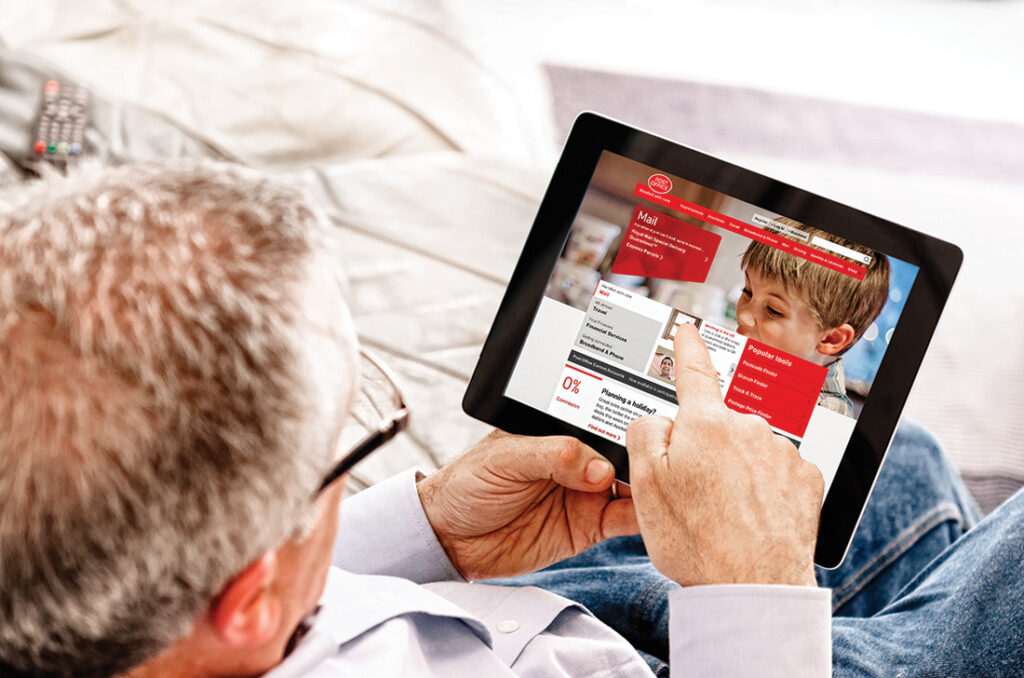This interview has been edited for clarity and brevity. For our US readers, the UK Post Office is different to the US Post Office in that the UK Post Office doesn’t deliver any mail. As Darren puts it, “the UK Post Office is like the shop front, whereas it is the Royal Mail that delivers the goods”. The UK Post Office also has a broader offering – it is as big in mail as it is in financial services and government services, offering mortgages, travel money, and savings accounts.
Tom: What’s the latest at the Post Office?
Darren: We’re going through a massive transformation to make sure we’re as relevant tomorrow as we are today. That includes addressing many of the things people don’t know about us which might be a barrier for them doing business with us, for example, our opening times. Many don’t realise that we’ve got over 4,000 branches open on Sundays now, which is more than McDonald’s and Tesco. Add in the fact people can use our branches to pay in and out money from nearly all high street banks, at a time when many banks are leaving the high-street, we suddenly become relevant to a segment who wouldn’t have previously thought about us before.
Extended opening hours is just one part of a much wider transformation, which as you’d expect also includes digital. I’ve been in the business for nearly six years now and it’s a really nice feeling to be driving a part of the future success of a brand that most of our customers have grown up with. It’s nice to be trusted with that kind of legacy.
Tom: The last few months we’ve had a huge amount of news coverage around the impact of social media on society and politics. What words would you use to describe the world of social media today?
Darren: There’s a degree of nervousness from the customer side. The conversation around trust is more important than ever, especially since Trump started talking about fake news. It’s become higher on the agenda and people are more sceptical about the things they share. That’s driving a lot of people towards encrypted, private social networking like WhatsApp – the whole industry is becoming a lot more private.
There’s also a lot of integration. Firstly, there’s a lot of acquisitions between the big players like Facebook fighting over other networks, like Instagram. Secondly, social is becoming a lot more integrated into teams and business-as-usual processes through ways of working, tools and API integrations.
Tom: What were the things that you were initially thinking about when you set off to create the Post Office’s social media strategy?
Darren: The trigger point was the overall business and their actions. The business created a new vision to take us forward for the next few years and our approach to social media just wasn’t aligned to that. After that moment of realisation my focus turned to customer segments to really understand our customers, especially those that are key to our future profitability.
Tom: How did you go about that? What kinds of research did you do with those customer segments?
Darren: I worked closely with our insight team who do a lot of the research on our segments. One of them we call Work hard, play hard. We had lots of research about their behaviours from a more traditional sense, and from a commercial sense, in terms of how often they come into the Post Office.
What was missing was the social behaviours. We didn’t really have any understanding in terms of how they consumed social media, what type of things they’re interested in hearing about, and when they used social at different parts of their consumer journey.
To fill that gap we did two things. We’ve got a customer panel, which is a survey panel of 1,000 customers which was already segmented against our key customer segments. We gave them a few questions to help us understand more about their typical behaviour.
We also did data research as well, using resources like GlobalWebIndex, to understand more broadly what was going on. We fused all that together to create stories in terms of the behaviours of our various segments.
Tom: At Netbase Live you talked about your segments using names and faces. How useful is it to assign names and faces to user personas?
Darren: Very useful. As marketers, communicators, we’re dealing with people at the end of the day. Seeing a picture of someone and a name, reminds you that you are talking to people, not just a number. That influences the decisions you make. It’s a nice reminder: in the age of automation it’s increasingly becoming more distant.
It’s really good internally as well. When I talk to other stakeholders around the business who maybe don’t work in marketing or communications it helps them understand what we’re trying to achieve here, which is a customer-focused social media strategy.
Tom: How did you choose the networks the Post Office focuses on?
Darren: They were chosen based on what our segments told us they use at different points in the customer journey.
For example the Work hard, play hard segment we named Ben. Ben uses social media for entertainment. He does follow brands on social, but he follows primarily to be entertained. From a commerce perspective, we know that if we want to reach Ben then we need to be on the platforms that entertain him, Facebook, Instagram, and YouTube.
We also know if we want to actually cut through on his news feed on these three networks, then we need to go out with content that is entertaining and a bit weird.
For example, we’re a number one player in travel money. We need to sustain that position by going out to market with messages that demonstrates our leadership in this space. One of the ways we do this is by doing travel barometers, which compare the costs of key items in foreign countries. We just recently completed a barometer that compares European cities. We identified the most expensive, and the cheapest, and some in between.
Amsterdam was one of those cities. We created a short video for Facebook that said three things that might surprise you about Amsterdam. We started the video with the fact that there were 8,000 bicycles a year dumped in the canal. The ending to that video was then a link to our report.
Tom: A number of people reading this will want to know how you get attention-grabbing but more risky posts past management who may be risk averse. How do you approach this?
Darren: One of the ways I reassure them is through ‘Test and Learn’. The moment you say ‘Test and Learn’ it gets you permission to do something a bit weird. It seems to give reassurance. From that, you get the data, and the insight, to reassure them post-campaign that it was a good decision.
The other thing is wider research. Who can argue with data from actual customers? To get that right at the start is really important for each discussion because it creates a solid business case. We’re also lucky because in the Post Office there is that degree of being bold and brave. The business wants to be like that.
Tom: And on the other end, how do you assess the success of your campaigns?
Darren: We’re quite single-minded so we always focus on one objective for anything we put out on social. It’s either to generate awareness, engagement, or sales. We use the likes of Facebook Pixel to help understand that.
If I use the Amsterdam example which I just talked about. The way we assessed that campaign was engagement, and by engagement we set the objective as video views. We’re quite harsh to ourselves in that we measure a view as someone who watched half the video (rather than 3 second views that some brands measure) because we see that as a stronger sign that somebody has actually engaged with it.
We also look at retargeting opportunities. Any video you go out with on Facebook you can re-target people who’ve watched that. Working with colleagues in marketing, we’d always make sure there’s an opportunity for them to go out with a message on Facebook that’s more salesy. From that, we can then look at attribution modelling and things like that.
We look at sentiment as well. It’s all very well going out with these campaigns but if they’re generating the wrong sentiment, that can stick on the brand. All of our campaigns take that into account. All of our sentiment is manually coded by our service team.
Tom: The sentiment is manually coded by a service team! That’s a lot of work. Do you use any automated sentiment?
Darren: Yeah, it’s a bit hit and miss though. I’ve yet to come across a tool that does it well. The data pours through into Lithium and it’s automatically categorised but the team then manually change it based on the accuracy.
Tom: If you were talking to an organization that was in the early stages of their social media journey, what tips would you give them?
Darren: The first one is listen. Before we learn to drive most people have been passengers, which allows you to learn the rules of the road before you start yourself. I think that’s true with social media. Just take a back seat, see what’s going on daily with your competitors, do some research around your customers as well. See how they use social media. But don’t dive in and do stuff because that could really be damaging to your brand. You’re also not going to be able to demonstrate business value either because you’ve got nothing to ladder it back up to.
My second thing would be not to spend a lot of money on it until you’ve got a clear direction and a clear sense of purpose. Try and do it as cost-effectively as possible. Try not to outsource it, either. Social media is something that all businesses need today and that expertise needs to be in-house. Make mistakes. Be bold. Build up that knowledge.
Only by building up that knowledge can you then have confident discussions with agencies when you reach the point that you are ready to outsource. At least you’ll know what your community is about, and what they stand for.
The third thing is find good tools. Tools can be a massive time saver. There’s loads of free tools on the market to help you assess performance, find out more about your customers. You don’t need to spend lots of money to buy enterprise tools when you’re early on in the journey. Five years ago in the Post Office we didn’t have any enterprise tools ourselves. We just used free tools. It worked well, at that time.
Tom: Perfect. Thank you for your time Darren.
Darren: Pleasure.




